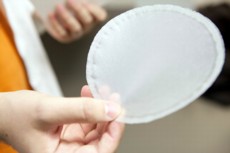Home > Press > Nanofibrillar cellulose film to ease performing medical tests
 |
Abstract:
Researchers at Aalto University have succeeded in developing a durable and affordable nanofibrillar cellulose film platform to support medical testing. New environmentally friendly, reliable nanofibrillar cellulose (NFC) platforms are more diverse than plastic films.
Nanofibrillar cellulose film to ease performing medical tests
Helsinki, Finland | Posted on October 23rd, 2012New film can be made, for instance, hydrophobic, hydrophilic and the electric charge can be changed. This will enhance the possibility of conducting thousands of different medical tests at home or in physicians' receptions instead of waiting for results from laboratories.
A platform is coated with the new film in the factory. The film is injected with substances that will react to the tested substance. At the place of testing, blood, water or another test material will be applied on to the film. The antibody injected onto the film will absorb the sample, depending on whether it contains substances causing allergic reactions, or bacteria, for example. Then the test result is visualised with the help of colour‑changing chemistry, for example.
Thanks to the new film, various tests can be conducted faster without compromising reliability. It will now be easier to detect microbes that cause illnesses in the physician's reception, or to monitor allergens at home. In addition to medical diagnostics, the film can be utilised to study water purity, for example, says doctoral candidate Hannes Orelma at Aalto University.
Previous attempts to produce a nanofibrillar cellulose platform have failed when the porous plate absorbed part of the sample. Now researchers have developed a method of producing a water‑proof nanofibrillar cellulose gel that will not absorb samples. They have also made great efforts to ensure sufficient film durability.
The article Surface Functionalized Nanofibrillar Cellulose (NFC) Film as a Platform for Immunoassays and Diagnostics was published in Biointephases journal. North Carolina State University participated in the study in addition to Aalto University. The research project was funded by Tekes - Finnish Funding Agency for Technology and Innovation.
School of Chemical Technology, Aalto University
####
About Aalto University
Established in 2010, the Aalto University is a new university with centuries of experience. The Aalto University was created from the merger of three Finnish universities: The Helsinki School of Economics, Helsinki University of Technology and The University of Art and Design Helsinki. Aalto University School of Science and Technology has been divided into four new schools starting from 1st of January 2011. The six schools of Aalto University are all leading and renowned institutions in their respective fields and in their own right.
The combination of six schools opens up new possibilities for strong multi-disciplinary education and research. The new university's ambitious goal is to be one of the leading institutions in the world in terms of research and education in its own specialized disciplines.
For more information, please click here
Contacts:
Doctoral candidate
Hannes Orelma
tel. + 358 50 344 1074
Associate professor
Monika Österberg
+.358 50 5497218
Professor Janne Laine
tel. + 358 9 47001
Copyright © Aalto University
If you have a comment, please Contact us.Issuers of news releases, not 7th Wave, Inc. or Nanotechnology Now, are solely responsible for the accuracy of the content.
| Related Links |
![]() The article online (springerlink.com):
The article online (springerlink.com):
| Related News Press |
News and information
![]() Simulating magnetization in a Heisenberg quantum spin chain April 5th, 2024
Simulating magnetization in a Heisenberg quantum spin chain April 5th, 2024
![]() NRL charters Navy’s quantum inertial navigation path to reduce drift April 5th, 2024
NRL charters Navy’s quantum inertial navigation path to reduce drift April 5th, 2024
![]() Discovery points path to flash-like memory for storing qubits: Rice find could hasten development of nonvolatile quantum memory April 5th, 2024
Discovery points path to flash-like memory for storing qubits: Rice find could hasten development of nonvolatile quantum memory April 5th, 2024
![]() Good as gold - improving infectious disease testing with gold nanoparticles April 5th, 2024
Good as gold - improving infectious disease testing with gold nanoparticles April 5th, 2024
Thin films
![]() Utilizing palladium for addressing contact issues of buried oxide thin film transistors April 5th, 2024
Utilizing palladium for addressing contact issues of buried oxide thin film transistors April 5th, 2024
Chemistry
![]() What heat can tell us about battery chemistry: using the Peltier effect to study lithium-ion cells March 8th, 2024
What heat can tell us about battery chemistry: using the Peltier effect to study lithium-ion cells March 8th, 2024
![]() Nanoscale CL thermometry with lanthanide-doped heavy-metal oxide in TEM March 8th, 2024
Nanoscale CL thermometry with lanthanide-doped heavy-metal oxide in TEM March 8th, 2024
Discoveries
![]() Chemical reactions can scramble quantum information as well as black holes April 5th, 2024
Chemical reactions can scramble quantum information as well as black holes April 5th, 2024
![]() New micromaterial releases nanoparticles that selectively destroy cancer cells April 5th, 2024
New micromaterial releases nanoparticles that selectively destroy cancer cells April 5th, 2024
![]() Utilizing palladium for addressing contact issues of buried oxide thin film transistors April 5th, 2024
Utilizing palladium for addressing contact issues of buried oxide thin film transistors April 5th, 2024
Announcements
![]() NRL charters Navy’s quantum inertial navigation path to reduce drift April 5th, 2024
NRL charters Navy’s quantum inertial navigation path to reduce drift April 5th, 2024
![]() Discovery points path to flash-like memory for storing qubits: Rice find could hasten development of nonvolatile quantum memory April 5th, 2024
Discovery points path to flash-like memory for storing qubits: Rice find could hasten development of nonvolatile quantum memory April 5th, 2024
|
|
||
|
|
||
| The latest news from around the world, FREE | ||
|
|
||
|
|
||
| Premium Products | ||
|
|
||
|
Only the news you want to read!
Learn More |
||
|
|
||
|
Full-service, expert consulting
Learn More |
||
|
|
||








